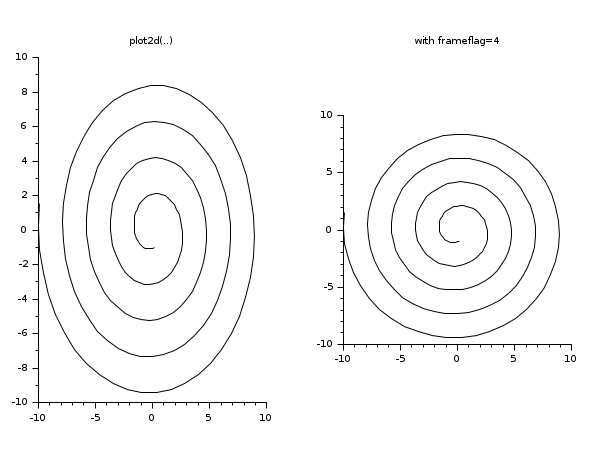Please note that the recommended version of Scilab is 2026.0.0. This page might be outdated.
See the recommended documentation of this function
isoview
tunes isometric rendering of graphical axes
Syntax
isoview isoview on isoview off isoview(idGraphics [,"on"|"off"]) isoview(xmin, xmax, ymin, ymax) // DEPRECATED. use replot()
Arguments
- "on" | "off" | <none>
- Enables or disables or switches the isometric rendering for all considered axes.
- idGraphics
- Vector of graphic handles. All the related axes are processed. By default, the current axes is processed.
- xmin, xmax, ymin, ymax
- Four decimal numbers: new axes bounds.
 These parameters will be removed from Scilab 6.1. Please used replot after
These parameters will be removed from Scilab 6.1. Please used replot afterisoviewinstead.
Description
isoview is used to set or relax isometric rendering scales
on the x, y (and z) axes, without changing the size of the graphic window.
isoview() or simply isoview
toggles the isoview status of the current axes, and keeps its current
bounds: isometric scales are set whenever
they were free, or scales are relaxed whenever they were isometric.
isoview("on") or isoview on
sets isometric scales for the current axes.
isoview("off") or isoview off
relaxes x, y (and z) scales for the current axes.
isoview(idGraphics,..) runs on axes related
to each graphic object listed in the vector idGraphics:
- If
idGraphics(i)is a figure's handle, all its Axes are considered. - If
idGraphics(i)is an Axes, it is considered as is. - If
idGraphics(i)is the handle of a sub-axes component(such as a polyline, a compound, etc), its hosting axes is considered.
isoview(xmin, xmax, ymin, ymax) sets the current
axes in isometric mode, and then sets its bounds to the given values.
 | This usage is deprecated and will be removed from Scilab 6.1 onwards. Please use
replot after
isoview instead. |
 | The current axes graphical entity is still the same after calling isoview(..). |
 | To plot some curves directly in isometric mode without calling
isoview afterwards, the plot2d(...,frameflag=4)
option may be used at call time. |
Examples
t = [0:0.1:2*%pi]'; clf nc = 3; subplot(2,nc,1) plot2d(cos(t),sin(t)) xtitle("True circle") a1 = gca(); subplot(2,nc,nc+1) plot2d(cos(t),sin(t)) isoview subplot(2,nc,2) plot2d(7*cos(t),2*sin(t)) xtitle("True ellipse") a2 = gca(); subplot(2,nc,nc+2) plot2d(7*cos(t),2*sin(t)) isoview // plot of a sphere using facets computed by eval3dp deff("[x,y,z] = sph(alp,tet)",[ "x = r*cos(alp).*cos(tet)+orig(1)*ones(tet)"; .. "y = r*cos(alp).*sin(tet)+orig(2)*ones(tet)"; .. "z = r*sin(alp)+orig(3)*ones(tet)"]); r = 3; orig = [0 0 0]; [xx,yy,zz] = eval3dp(sph,linspace(-%pi/2,%pi/2,40),linspace(0,%pi*2,40)); subplot(2,nc,3) plot3d(xx, yy, zz, alpha=60, flag=[color("green") 8 4]) xtitle("True sphere") a3 = gca(); subplot(2,nc,nc+3) plot3d(xx, yy, zz, alpha=60, flag=[color("green") 8 4]) isoview // Switching isoview status for all axes isoview(gcf()) // Forcing isoview for all axes of the current figure isoview(gcf(), "on") // Relaxing isoview for the current axes isoview off // Setting isoview for top axes isoview(gcf(),"off") isoview([a1 a2 a3], "on")

// Using plot2d(..., frameflag=4) : r = linspace(1,10,200); t = r*3; scf(); subplot(1,2,1) plot2d(r.*sin(t),r.*cos(t)) xtitle("plot2d(..)") subplot(1,2,2) plot2d(r.*sin(t),r.*cos(t),frameflag=4) xtitle("with frameflag=4")

See also
- replot — redraw with new boundaries the current or a given set of axes
- Axes properties — description of the axes entity properties
History
| Version | Description |
| 6.0 |
|
| Report an issue | ||
| << graduate | axes_operations | newaxes >> |